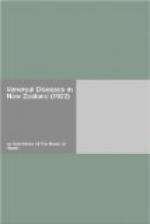Inasmuch as one of the many letters addressed to the Committee favoured the adoption of the Continental system of licensed houses of prostitution, with medical inspection of the inmates, it seems desirable to examine the arguments for and against such a proposal. Those who support it contend that so long as human nature remains as it is prostitution will continue, therefore it is better that it should be regulated with a view to controlling the spread of disease. It is also urged that the system acts as a safeguard against sexual perversion by providing an outlet for the unrestricted appetites of men; that in its absence clandestine prostitution increases, and innocent girls are more likely to be led astray or become the victims of sexual violence. Apart from the moral aspect of the case, these arguments are entirely fallacious; and even in the countries where the licensed-house system prevails enlightened public opinion has come to that conclusion. In the first place, the idea that the system tends to lessen disease is a dangerous delusion. Owing to the fact, already referred to, that venereal disease in the early stages is difficult to detect in women, even by skilled experts working with the best methods and with practically unlimited time at their disposal, the routine inspection given, for example, in the French and German houses is no guarantee of the inmates being free from communicable disease even at the time of inspection.
Flexner, who spent two years in making inquiries and writing his classic work on “Prostitution in Europe,” is most emphatic on this point. The experience of the American troops in the Great War is further strong confirmation. The following is an extract from an article published by the American Red Cross in May, 1918: “During the months of August, September, October, and the first half of November, the houses of prostitution flourished and were half-filled with soldiers. On November 15th rigid orders were issued placing these houses out of bounds, and the immediate result was a great reduction of sexual contacts. As a result there was a steady decline in venereal infections, and the monthly rate per 1,000, which in October reached 16.8, dropped in January to 2.1 among the white troops. During the same period there was an even more striking drop in the infections among the negro labourers, the percentage dropping from 108.7 per 1,000 a month to 11 per 1,000. No statistics could speak more eloquently for the doctrine of closing the houses of prostitution. Our studies showed numerous infections coming from houses ‘inspected’ three times a week.”
In May, 1921, a conference (the North European Conference on Venereal Diseases), in which England, Finland, Germany, Holland, Norway, Sweden, and Denmark participated, passed the following resolution: “This conference, having considered the general measures for the combating of venereal diseases which have been adopted by the participating countries, is unanimously of the opinion, so far as the experience of these countries is concerned, that the legal and official toleration of professional prostitution has been found to be medically useless as a check on the spread of venereal diseases, and may even prove positively harmful, tending as it does to give official sanction to a vicious trade.”




